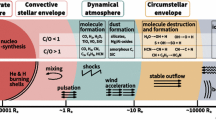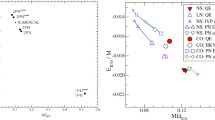Abstract
The high radial velocity amplitude (235 km s−1) and 1.70-day orbital period of the B3V optical counterpart of the X-ray source LMC X-3 set a lower limit of 6–10 M⊙ for the mass of the X-ray source, strongly suggesting that it is a black hole1,2. An observational upper limit to the mass of this compact star can be derived which, in combination with considerations about the evolutionary history of the system, allows us to derive an upper limit to the (zero age) mass of the progenitor of the compact star in this system: ⩽ 80±10 M⊙. From the orbital parameters of pulsating massive X-ray binaries we find that stars with masses up to ⩽40 (±5) M⊙ (and, if supernova (SN) mass ejection is symmetric, up to 60 (±7) M⊙) terminate life as neutron stars. Thus, if LMC X-3 is a black hole, the lower mass limit for terminating life as a black hole is in the range between 40 (60 M⊙) and 80 M⊙. Together with the initial mass function of massive stars this yields a black hole formation rate in the galaxy about two orders of magnitude smaller than the neutron-star formation rate. The direct progenitors of the black holes (just before the supernova) were massive Wolf–Rayet (WR) stars.
Similar content being viewed by others
References
Cowley, A. P., Crampton, D., Hutchings, J. B., Remillard, R. & Penfold, J. E. Astrophys. J. 272, 118–122 (1983).
Paczynski, B. Astrophys. J. Lett. 273, L81–L84 (1983).
Van der Klis, M., Tjemkes, S. & Van Paradijs, J. Astr. Astrophys. 126, 265–268 (1983).
Flannery, B. P. & Van den Heuvel, E. P. J. Astr. Astrophys. 39, 61–67 (1975).
Fryxell, B. A. & Arnett, W. D. Astrophys. J. 243, 994–1002 (1981).
Fryxell, B. A. Astrophys. J. 234, 641–652 (1979).
Savonije, G. J. & Papaloizou, J. Mon. Not. R.astr. Soc. 203, 581–593 (1983).
Eggleton, P. P. Astrophys. J. 268, 368–369 (1983).
Blaauw, A. Bull. astr. Inst. Netherlands 15, 265–290 (1961).
Van der Linden, Th. J. Astr. Astrophys. (in the press).
Paczynski, B. in Structure and Evolution of Close Binary Stars (eds Eggleton, P. et al.) 75–80 (Reidel, Dordrecht, 1976).
Van den Heuvel, E. P. J. Fundamental Problems in the Theory of Stellar Evolution, IAU Symp. No. 93, 155–176 (1981).
Meyer, F. & Meyer-Hofmeister, E. Astr. Astrophys. 78, 167–176 (1979).
Taam, R. E., Bodenheimer, P. & Ostriker, J. P. Astrophys. J. 222, 269–280 (1978).
Conti, P. S. in Wolf-Rayet Stars: Observations, Physics, Evolution (eds de Loore, C. W. H. & Willis, A. J.) 3–22 (Reidel, Dordrecht, 1982).
Willis, A. J. in Wolf-Rayet Stars: Observations, Physics, Evolution (eds De Loore, C. W. H. & Willis, A. J.) 87–104 (Reidel, Dordrecht, 1982).
Barlow, M. J. in Wolf-Rayet Stars: Observations, Physics, Evolution (eds de Loore, C. W. H. & Willis, A. J.) 149–172 (Reidel, Dordrecht, 1982).
Abbott, D. C. in Wolf-Rayet Stars: Observations, Physics, Evolution (eds de Loore, C. W. H. & Willis, A. J.) 185–196 (Reidel, Dordrecht, 1982).
Chiosi, C. in Wolf-Rayet Stars: Observations, Physics, Evolution (eds De Loore, C. W. H. & Willis, A. J.) 323–341 (Reidel, Dordrecht, 1982).
Maeder, A. in Wolf-Rayet Stars: Observations, Physics, Evolution (eds De Loore, C. W. H. & Willis, A. J.) 371–375 (Reidel, Dordrecht, 1982).
Arnett, W. D. in Physics and Astrophysics of Neutron Stars and Black Holes (eds Giacconi R., Ruffini, R.) 356–436 (North-Holland, Amsterdam, 1978).
Chiosi, C., Nasi, E. & Sreenivasan, S. R. Astr. Astrophys. 63, 103–124 (1978).
Lamers, H. J. Astrophys. J. 245, 593–608 (1981).
Van Beveren, D. thesis, Free Univ. of Brussels (1980).
De Loore, C. in Wolf-Rayet Stars: Observations, Physics, Evolution (eds de Loore, C. & Willis, A. J.) 343–358 (Reidel, Dordrecht, 1982).
Maeder, A. Astr. Astrophys. 99, 97–107 (1981).
Watson, M. G., Warwick, R. S. & Corbet, R. H. D. Mon. Not. R. astr. Soc. 199, 915–924 (1982).
Warwick, R. S., Watson, M. G. & Sims, M. R. Space Sci. Rev. 30, 461–466 (1981).
Rappaport, S. A. & Joss, P. C. in Accretion-Driven Stellar X-ray Sources (eds Lewin, W. H. G. & van den Heuvel, E. P. J.) 1–39 (Cambridge University Press, 1983).
Kelley, R., Rappaport, S. & Petre, R. Astrophys. J. 238, 699–709 (1980).
Abbot, D. C. Astrophys. J. 263, 723–735 (1982).
De Greve, J. P. thesis, Free Univ., Brussels (1976).
Van den Heuvel, E. P. J. in Accretion-Driven Stellar X-ray Sources (eds Lewin, W. H. G. & van den Heuvel, E. P. J.) 303–341 (Cambridge University Press, 1983).
Garmany, C. D., Conti, P. S. & Chiosi, C. Astrophys. J. 263, 777–790 (1982).
Tammann, G. A. Ann. N.Y. Acad. Sci. 302, 61–80 (1977).
Manchester, R. N. & Taylor, J. H. in Pulsars (Freeman, San Francisco, 1977).
Van den Heuvel, E. P. J. Vistas Astr. 25, 95–108 (1981).
Author information
Authors and Affiliations
Rights and permissions
About this article
Cite this article
van den Heuvel, E., Habets, G. Observational lower mass limit for black hole formation derived from massive X-ray binaries. Nature 309, 598–600 (1984). https://doi.org/10.1038/309598a0
Received:
Accepted:
Issue Date:
DOI: https://doi.org/10.1038/309598a0
- Springer Nature Limited
This article is cited by
-
Long gamma-ray burst progenitors: boundary conditions and binary models
Astrophysics and Space Science (2007)





